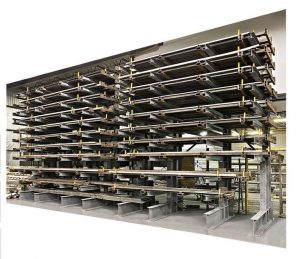 A 12-step guide to the safe operation and maintenance of cantilever racking
A 12-step guide to the safe operation and maintenance of cantilever racking
November 18, 2014 REDWIRE is news you can use from leading suppliers. Powered by FRASERS.
Posted by Econo-Rack Storage Equipment
New & used, shelving, industrial shelving, metalware shelving, boltless shelving, dexion slotted angle, wide span s... Read more
Subscribe
Free REDWIRE e-newsletter

When using cantilever racks in your facility to store large or awkward items, there are a number of factors that need to considered to ensure the safe operation and continued maintenance of the racking systems.
1. Do not add arms or modify the racks in any way without first contacting your storage equipment supplier and discussing this with the engineering department.
2. Always use appropriate safety equipment when servicing the racks. Never climb or stand on the racking.
3. Place loads onto racks vertically, and train operators to set loads gently onto racks. Never drop, push or slide them into position.
4. Do not overload rack arms, uprights or decking. Each rack system is custom designed to meet the load specifications that were established at the time of purchase. Do not exceed these loads without contacting your storage equipment supplier and discussing this with the engineering department.
5. Train equipment operators to avoid rack contact. A rack system’s lifespan is directly related to operator care.
6. Be sure to keep all aisles clear of debris. Do not store material in aisles, and make sure employees and visitors stay clear of aisles while equipment is present.
7. Ideally, maintenance should be performed semi-annually. During the maintenance routine, check all connections for missing or loose bolts. Replace any bolt or nut that is missing or has been damaged, and tighten any bolts that have come loose.
8. Check all arms for damage and replace any that have been bent or that fall below horizontal when loaded. Do not attempt to straighten a bent arm.
9. Inspect welds on arms and bases for cracks or damage.
10. Inspect horizontal and diagonal bracing for damage, and replace any angles or flat bar straps that have been bent or broken.
11. Inspect anchors and tighten as necessary.
12. Inspect rack for plumb. Rack uprights should be vertical to within one inch per 20 feet of height when unloaded. Shim under the bases or columns as necessary.
It is an employer’s responsibility to ensure the safety of its employees. Racking is one of the many areas within a facility that requires special attention when it comes to safety. For more helpful information related to racking and safety, visit Econo-Rack Storage Equipment’s website.
Share
Posted by Econo-Rack Storage Equipment
New & used, shelving, industrial shelving, metalware shelving, boltless shelving, dexion slotted angle, wide span s... Read more